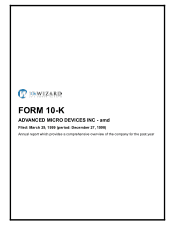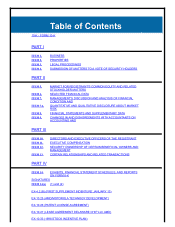AMD 1998 Annual Report Download - page 11
Download and view the complete annual report
Please find page 11 of the 1998 AMD annual report below. You can navigate through the pages in the report by either clicking on the pages listed below, or by using the keyword search tool below to find specific information within the annual report.in cellular telephones and related equipment to enable users to add and modify
frequently called numbers and to allow manufacturers to preprogram firmware
and other information. In networking applications, Flash memory devices are
used in hubs, switches and routers to enable systems to store firmware and
reprogrammed Internet addresses and other routing information.
Competition in the market for Flash memory devices is increasing as existing
manufacturers introduce competitive products and industry-wide production
capacity increases, and as Intel continues to aggressively price its Flash
memory products. Almost all of our Flash memory devices are produced in Aizu-
Wakamatsu, Japan through Fujitsu AMD Semiconductor Limited (FASL), our joint
venture with Fujitsu Limited.
EPROMs. EPROMs represent an older generation of erasable, programmable read-
only memory technology which is used primarily in the electronic equipment
industry. These devices are used in cellular telephones, wireless base
stations, telecommunication switching equipment, automotive applications, PC
hard disk drives, printer controllers, industrial machine controls and
numerous other types of electronic equipment to store firmware which controls
the equipment's operation. EPROMs are generally preferred over more expensive
Flash memory devices in applications where end users do not need to reprogram
the information stored on the IC. We believe the market for EPROMS, which is
significantly smaller than the market for Flash memory devices, will continue
to decline as EPROMs are replaced in various applications by Flash memory
devices.
Communications Group
Communications Group products ($519 million, or 20 percent, of our 1998 net
sales) include telecommunication products, networking and input/output (I/O)
products and embedded processors.
Telecommunication Products. Our telecommunication products are used
primarily in public communications infrastructure systems and cordless
telephony applications. Specifically, the products are used in equipment such
as central office switches, digital loop carriers, wireless local loop
systems, private branch exchange (PBX) equipment and voice/data terminals.
Among our more significant products for the communications market are our line
card products. In modern telephone communications systems, voice
communications are generally transmitted between the speaker and the central
office switch in analog format, but are switched and transmitted over longer
distances in digital format. Our subscriber line interface circuits (SLIC) for
line cards connect the user's telephone wire to the telephone company's
digital switching equipment. Our subscriber line audio processing circuits
(SLAC(TM)) line cards are coder/decoders which convert analog voice signals to
a digital format and back. Our non-cellular telephony products are used in
digital cordless phones.
Networking and I/0 Products. Our networking and I/O products are used in the
data communication and internetworking industry to establish and manage
connectivity. The products are used within PCs, workstations and printers as
well as in network infrastructure equipment such as hubs, switches and
routers.
We supply ICs for business and consumer applications utilizing the 1-
megabit-per-second, 10-megabit-per-second, 100-megabit-per-second and gigabit-
per-second Ethernet local area network standards. We also offer ICs that work
with central processing units to manage selected I/O functions such as small
computer system interface disk drive controllers and communications devices.
In addition, we supply products specially designed to add additional
functions, improve performance and reduce costs in computer peripheral,
interface or mass storage applications. These are generally special-purpose
products which are designed for a specific application. In the case of some
large customers, these products are tailored for specific customers' needs.
Embedded Processors. Embedded processors are general purpose devices, which
consist of an instruction control unit and an arithmetic and logic unit, and
are used to carry out a single application with limited user interface and
programmability. We also offer a line of C186 and C188 processors for use as
embedded processors in hard disk drives. We offer an expanding range of
embedded processors based upon x86 microprocessor technology for both
communications as well as handheld computing applications. These embedded
processors are derivative of the microprocessors we sell in PCs.
8
Source: ADVANCED MICRO DEVIC, 10-K, March 29, 1999
























